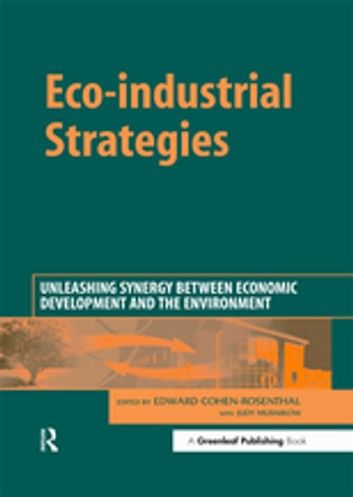| FindBook |
有 1 項符合
Eco-industrial Strategies的圖書 |
 |
Eco-industrial Strategies 出版社:Taylor and Francis 出版日期:2017-09-29 語言:英文 |
| 圖書館借閱 |
| 國家圖書館 | 全國圖書書目資訊網 | 國立公共資訊圖書館 | 電子書服務平台 | MetaCat 跨館整合查詢 |
| 臺北市立圖書館 | 新北市立圖書館 | 基隆市公共圖書館 | 桃園市立圖書館 | 新竹縣公共圖書館 |
| 苗栗縣立圖書館 | 臺中市立圖書館 | 彰化縣公共圖書館 | 南投縣文化局 | 雲林縣公共圖書館 |
| 嘉義縣圖書館 | 臺南市立圖書館 | 高雄市立圖書館 | 屏東縣公共圖書館 | 宜蘭縣公共圖書館 |
| 花蓮縣文化局 | 臺東縣文化處 |
|
|
Old-style manufacturing, embodied in industrial parks that litter the landscape, may soon become dinosaurs of industrial development. These "Jurassic Parks" of the past will be replaced by new eco-industrial parks (EIPs) that link manufacturers more closely together into an industrial ecosystem for business and environmental excellence.
Companies have always depended on a larger ecology of suppliers, customers, geography and market to be successful, but a popular mythology was that each company was an island. Abandoning this fantasy by consciously integrating into a larger industrial ecology is smart business that draws on the overall system of interactions to nourish corporate success-and the environment.
Eco-industrial development, born from the realisation that the places where we work waste too much and unnecessarily pollute the land, air, and water, simply stated, demands a better way of working. From eco-parks-most famously at Kalundborg in Denmark-to virtual networks, this progressive perspective on economic development is taking shape in communities across the United States and around the world. Eco-industrial Strategies is edited by Ed Cohen-Rosenthal, a pioneer in the field of industrial ecology, whose untimely passing early in 2002 has left this book as a legacy to his passion and commitment to improving both the environment and places in which people work. The book explores the key issues involved in eco-industrial development and identifies the stakeholders and their roles in such projects. In addition, it offers a compendium of eco-industrial development case studies.
While an increasing number of handbooks and manuals focus on eco-industrial development, no other book containing process analysis, a breakdown of stakeholder responsibility, and case study assessment exists. What sets this work apart is the pooling together of resources and knowledge from a wide array of sources within the eco-industrial field and the framing of the concept from multiple angles.
Eco-industrial Strategies aims to accomplish a two-step "inform and empower" process. First, it familiarises readers with eco-industrial development, its innovative proclivity and applicability to diverse circumstances. Second, it provides the fundamental tools and motivational creativity to implement independent eco-industrial projects. The introductory chapters of this book present several overarching concepts and perspectives of the field, which pay particular attention to the technological, economic and social elements.
The next section focuses on the role of the various stakeholders involved in eco-industrial development. Each chapter sets out to answer various questions relating to the stakeholders' place in the system, specifically: what are the stakeholders' particular interests, in what ways can they participate in the process, and how do they relate to other actors and stakeholders? These chapters also respond to questions regarding the relationship between stakeholders and eco-industrial development. Chiefly, they trace the flow of benefits, and various other impacts and repercussions, among and between the stakeholders and the development project. Since eco-industrial development involves countless groups and individuals, this book focuses on five distinct and comprehensive categories: namely, central government, local government, surrounding community, development community, and energy resources.
The third section outlines several matters related to conceptualisation, design, operation and assessment of eco-industrial projects. Concentrating on the core legal, environmental, management, financial, real estate and evaluative aspects, the book presents the critical components of each issue and also provides an understanding of the unique attributes eco-industrial development brings to the equation.
The case-study portion of this book provides vignettes of actual work in progress. Each chapter details the key characteristics of the effort and the process undertaken in developing the eco-industrial project. The studies focus primarily on issues considered in the preceding sections, such as project funding, stakeholder engagement and environmental stewardship. In addition, they recount achievements, threats to success, ways obstacles were overcome, and details on the project's future. Eco-industrial Strategies showcases development projects from around the world, including Asia, Canada, Denmark and the United States, situated in a variety of settings: for example, army bases, industrial parks and virtual networks. This eclectic mix of development structures and contexts is indicative of the diversity apparent in eco-industrial projects overall and allows readers to glean functional and constructive lessons adaptable to their particular circumstances. Accordingly, this section stands as a testament to the widespread applicability of eco-industrial development, and as inspiration for practitioners in both traditional and unconventional settings. An idea and practice still in its infancy, eco-industrial development will undergo many evolutions beyond what this collaborative work is able to capture. As a document of the concept's earliest theorists, Eco-industrial Strategies provides current and future readership with an understanding of eco-industrial development's foundations, its beginnings and its aspirations. Most excitingly, policy-makers, industry professionals, community developers, grass-roots activists, and all other readers yearning for a better way to work and live, will experience a glimpse of the thoughts, concerns, ambitions, technological insight, communities and economies that embody eco-industrial development.
|











